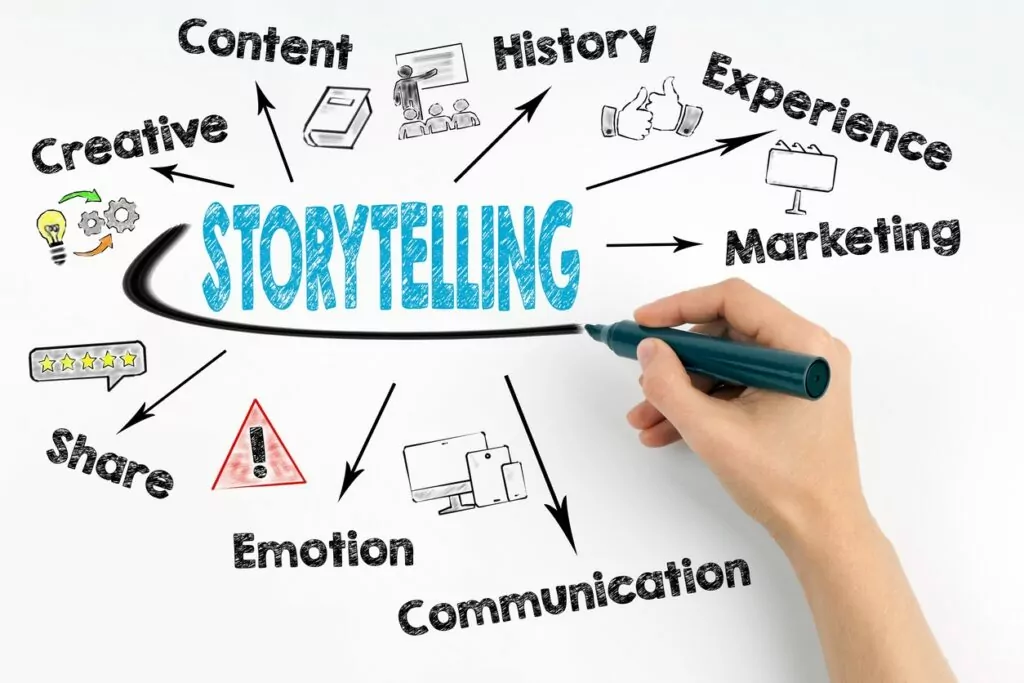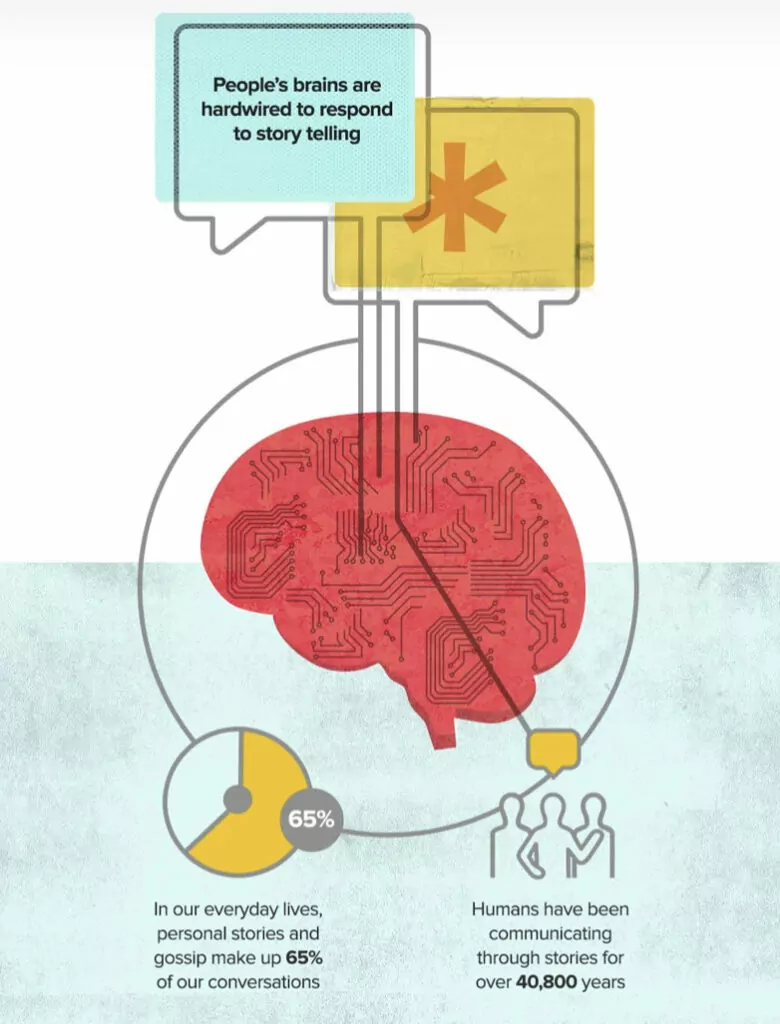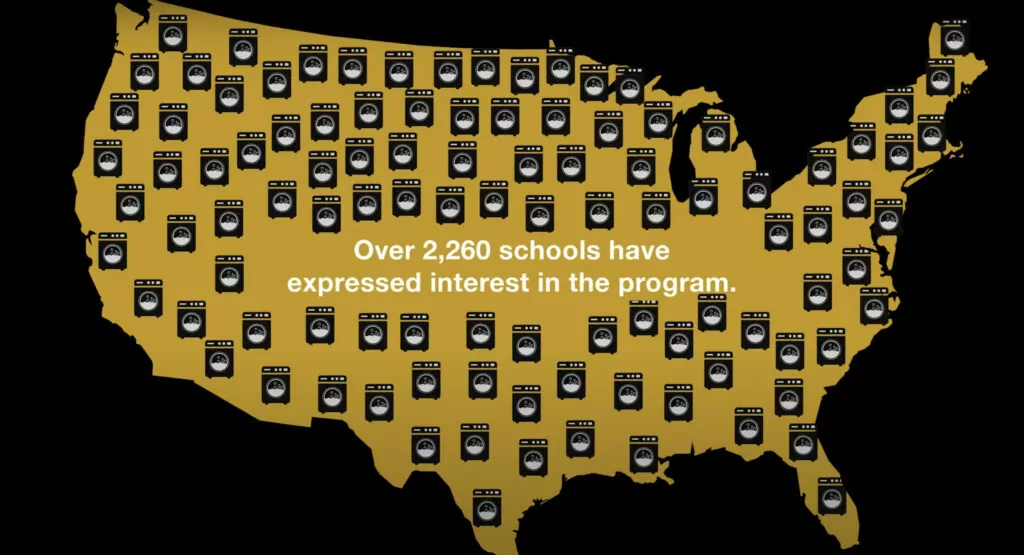How did Nike become one of the largest athletic shoe suppliers globally? They didn’t just sell a shoe–they sold a story of success despite obstacles. Their ads are filled with celebrity endorsements that tell this story. Storytelling for sales isn’t unique to Nike. Millions of other brands also use the same strategy to increase sales by appealing to more than just their audience’s logic.
Learn what brand storytelling for sales is and how you can use it to bring in more deals.
Key Takeaways:
- Brand storytelling appeals to the audience’s emotions for greater reactions and responses to your sales pitch.
- Brand storytelling humanizes your business which helps you relate better with your customers.
- Case studies, behind the scenes, and fictional stories all work in brand storytelling.
What Is Brand Storytelling (And Why Does It Work for Sales)?
No matter your age, industry, or level of education, everyone responds to a story. Scientific studies followed the brain’s response to stories and saw many areas of the brain light up to different emotions and details, not just the areas responsible for language processing.
Storytelling in sales improves your connection with your audience by humanizing your product and aligning your brand with an emotion, cause, or value. This connection makes your brand more memorable and your audience more receptive to your message. You can share these stories through social media, blog posts, video marketing, and in-person sales pitches.
Source: Neil Patel
Consider these examples of storytelling to spark your creativity:
- Show how your product benefits the consumer
- Tell an emotional story
- Connect to your audience by telling a relatable story
- Bring awareness to a need in society
- Align your brand with a cause or mission
- Give a glimpse behind the scenes of your company
Brand Storytelling Examples of Companies That Got It Right
Here are four sales storytelling examples of brands that created successful storytelling campaigns and saw an increase in sales:
Huggies: Educate Your Audience
Huggies used their marketing and sales efforts to educate their audience about infant health. For example, Project Hug brings clean diapers to families in need, educates parents on diaper changing health, and supports families with infants in the NICU. In addition, they launched the No Baby Unhugged campaign in Canada, where volunteers ensure all babies receive skin-to-skin contact after birth.
Their sales pitches often focus more on educating parents about these resources rather than listing the features or benefits of their diapers. Their sales have been steadily increasing because of their unique marketing and sales strategy.
Whirlpool: Align with a Social Cause
Whirlpool’s storytelling campaigns promote a social cause they support with their products. For example, their #CareCounts program installs washers and dryers in schools because studies showed 20% of students don’t have clean clothes, which increases their chances of skipping school.
Their brand stories aren’t just selling cleaner clothes. They promote what you can accomplish and do when you care for yourself by cleaning your clothes. In 2021, they made $22 billion in sales. About 30% of that was from their laundry and refrigeration segments.
Source: Whirlpool YouTube
Google: Emotional Storytelling
Google is one of the masters of emotional storytelling. Their most notable example was the “Parisian Love” video ad for the 2010 Super Bowl. In this ad, they told a love story entirely through Google searches. In 2020, they celebrated the tenth anniversary of the original storytelling ad by releasing a new story called “Loretta,” which again tells an emotional tale entirely by showcasing Google’s products and services.
These ads aren’t just fictional tales of love for an emotional response. They also show examples of how Google can improve people’s daily lives.
Warby Parker: Tells Their Brand Story
Warby Parker does more than tell customers how good their quality is. They show it through brand storytelling. Their commercials “Craftsmanship” and “How They’re Made” walk viewers through the manufacturing process. Their storytelling supports their company goal of making high-quality glasses at a fraction of the price so that everyone has access to eye care.
4 Tips for Using Brand Storytelling for Sales
These four tips will get you started with brand storytelling to increase your sales revenue.
1. Shift from Product-Centric to Customer-Centric Sales
A successful brand storytelling strategy focuses on the customer rather than the product. For example, instead of telling a story about how well your product performs, tell a story about how someone’s life improved because of your product.
Using case studies in a sales pitch is one way to support your claims and makes your sales efforts more relatable by focusing on the customer rather than the product.
2. Make Your Story Relevant to Your Viewers
Your story should make your audience care about your message by appealing to circumstances your primary customers can relate to. For example, Huggies focuses on stories about parents and infants using soft music and appealing to a parent’s need to nurture. In contrast, Nike uses athletic success stories with motivational music and a message to drive its audience to action since its primary customers are active adults.
3. Focus on an Emotion
To get the greatest response from your storytelling for marketing and sales, you must focus on one emotion that will drive the viewer or reader to action. Do you want them to feel sentimental or reminiscent? Are you looking to make them laugh? Do you want to evoke sympathy?
Telling stories about your brand’s charity work creates a feeling of sympathy, encouraging a customer to purchase from your brand to support that work. Likewise, a case study can give a sense of success that might move a customer to buy who wants to achieve the same success. You can also use the behind-the-scenes stories of your employees to humanize your business and build greater trust.
4. Keep It Simple
You don’t want to overload your readers or viewers with industry jargon or complex story plots. Instead, keep your message simple so it isn’t lost in an overly edited story.
Humor, a startling fact, or a relatable situation can catch your audience’s attention. Then, follow that intro with a simple journey of the main character that ends with your products or services bringing them the solution they need. This same format works for content marketing, sales pitches, and ads.
You don’t have to offer all your solutions in one sitting. Instead, you will be more effective by capturing their interest and encouraging them to return to your brand for more information.
Create a Storytelling Strategy That Converts
What stories does your brand have to share?
Use your case studies, brand experiences, and company values to generate leads and close sales with storytelling sales and marketing materials.
Contact us about our marketing automation platform and turn more leads into sales.









